Top 5 Australian National Parks to Visit in Spring
Thinking about Australian National Parks to Visit in Spring?
It’s the season when wildflowers carpet the ground, rivers run full, and the air feels fresh and alive.
This guide takes you through the top parks to explore, from iconic names to hidden gems that look their best in spring.
By the time you’re done, you’ll know exactly which parks suit your travel style, whether you’re after rainforest walks, desert drives, or mountain lookouts.
Each park has something unique to offer during this time of year.
Let’s dive into the places where spring transforms the outdoors into something unforgettable.
Best National Parks in Australia for Spring Travel
1. Blue Mountains National Park, New South Wales

The Blue Mountains in spring are a mix of crisp air, fresh greenery, and endless views.
Just outside Sydney, this park offers a quick escape where towering cliffs, waterfalls, and walking tracks feel even more inviting during the season.
The cooler weather makes it easier to take on longer hikes, from clifftop walks to valley trails.
Spring also brings new colour to the landscape, with native plants in bloom and mist rising through the eucalyptus forests.
The sound of birds carries across the escarpments, and lookouts reveal the blue haze that gives the region its name.
It’s a park that combines natural beauty with easy access, making it a favourite for both day trips and more extended stays.
Why Spring?
Spring is peak season in the Blue Mountains for good reason.
The weather is crisp and mild, making it perfect for long walks along clifftop trails or down into hidden valleys.
The bushland bursts into colour, with waratahs standing tall in bright red and delicate flannel flowers spreading across the tracks.
Waterfalls are at their best after the winter rains, so places like Wentworth Falls and Leura Cascades put on an impressive show against the fresh green backdrop.
Cool mornings roll into warm, sunny afternoons, giving the day a balance that’s ideal for exploring without the harsh heat of summer.
It’s also the season when the forest feels alive with sound and movement.
Lyrebirds scratch through the undergrowth, mimicking calls that echo through the trees, and other native wildlife becomes easier to spot as the bush regenerates.
Every walk in spring feels full of life and discovery.
What To Do:
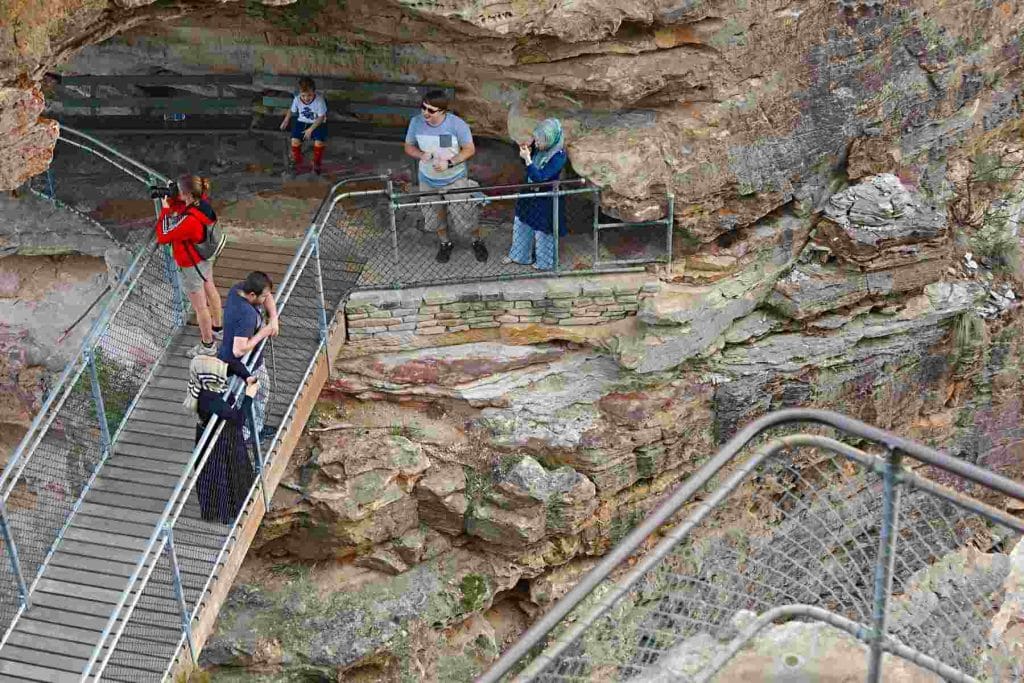
Spring is the perfect time to tackle hikes in the Blue Mountains, whether it’s a leisurely family stroll or a full-day trek.
The Three Sisters Walk at Echo Point is a must-do, leading to an iconic lookout over the rock formations and Jamison Valley. At sunset, the view turns golden and feels almost magical.
For something longer, a section of the Grand Cliff Top Walk links stunning vistas from Wentworth Falls to Katoomba.
Wentworth Falls itself is a highlight, with a moderate track leading to views of the multi-tiered cascade tumbling into a lush valley.
In spring, wattles and banksias bloom around the falls, making the scene even more photogenic.
The Valley of the Waters walk at Wentworth Falls passes several smaller cascades, while Govetts Leap in Blackheath delivers a dramatic lookout to a single-drop waterfall.
Between hikes, mountain villages like Leura and Blackheath are perfect spots to stop for coffee and pastries before heading back onto the trails.
Families will love Scenic World in Katoomba, with its valley-spanning cableway, glass-floored skyway, and the world’s steepest railway.
The rides drop into the ancient Jamison Valley, where boardwalks wind through temperate rainforest filled with towering tree ferns.
On clear spring days, the views from Scenic World’s lookouts stretch endlessly across the escarpments.
Keen for a day trip out of Sydney? The Blue Mountains: Three Sisters, Scenic World and Wildlife Park tour combines everything that makes this region special. Start the day with breakfast in the mountains before meeting koalas, kangaroos and more at a wildlife park. Ride the cableways and railway at Scenic World, then take in waterfalls, dramatic cliffs, and the famous Three Sisters rock formation. With meals, entry fees and transport included, it’s an easy way to explore one of Australia’s most iconic landscapes.
Flora and Fauna
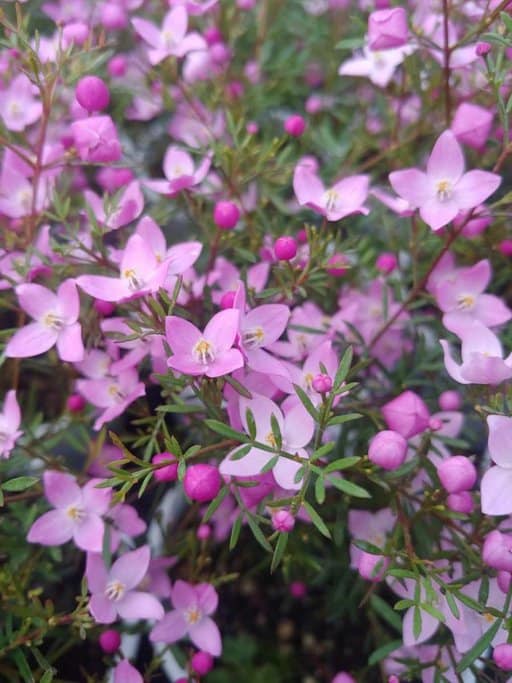
The Blue Mountains’ World Heritage bushland bursts into life during spring.
Fresh green growth spreads across the eucalypts, creating the famous blue haze that hangs over the valleys.
Along the walking tracks, wildflowers put on a colourful show.
Pink boronias and purple hoveas brighten the paths, while in October, the bold red waratah – New South Wales’ floral emblem – blooms proudly against the greenery.
Birdsong fills the air, from the sharp whip-crack call of eastern whipbirds to the chatter of cockatoos overhead.
In the valleys, swamp wallabies and eastern grey kangaroos are often seen in the cool mornings, especially around Glenbrook and Megalong.
At Euroka Clearing in Glenbrook, kangaroos graze freely on the open grass, a sight that always delights kids.
Spring is also the season for one of the park’s most remarkable wildlife encounters.
The superb lyrebird is often spotted striding across trails, and during mating season, males put on incredible displays.
Their tails fan out in elaborate patterns as they mimic the calls of other birds in the rainforest gullies – a moment that feels unforgettable if you’re lucky enough to witness it.
Practical Tips
Most of the Blue Mountains National Park is free to enter, with only the Glenbrook precinct charging a small $8 vehicle fee.
Just two hours by car or train from Sydney, it’s an easy spring day trip or a weekend escape.
The weather can swing from mild afternoons to chilly nights, so dressing in layers keeps you comfortable on the trails and around campfires.
For those keen to camp, Euroka Campground is a favourite spot where kangaroos often graze around tents at dawn.
There are also remote walk-in sites for hikers chasing solitude, while towns like Katoomba and Leura provide plenty of cosy lodges and guesthouses.
Families will find lookouts accessible by car or paved paths, and picnic spots like Govetts Leap in Blackheath make for memorable lunches with a view.
Accessibility is well-considered in the park, with wheelchair-friendly lookouts at Echo Point and Govetts Leap, along with easy-grade tracks near the Blue Mountains Heritage Centre in Blackheath.
2. K’gari (Fraser Island), Great Sandy National Park
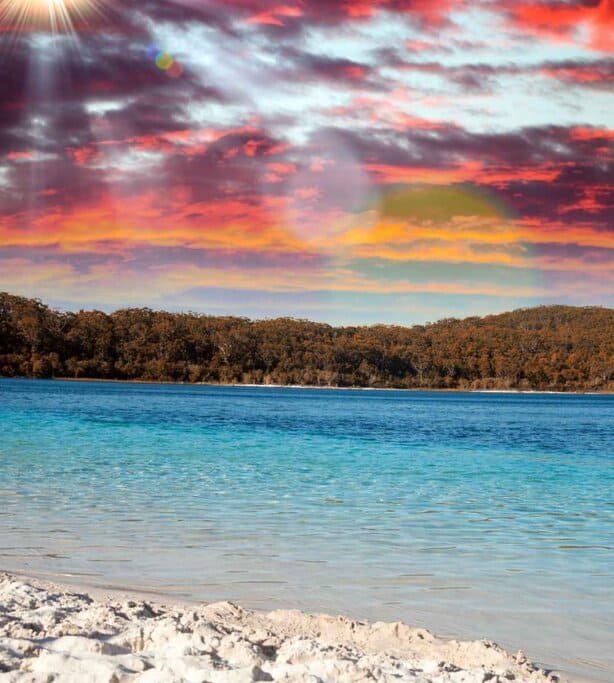
K’gari, the world’s largest sand island, is a spring escape of beaches, lakes, and rainforest.
With mild days and lower humidity, it’s the ideal season to explore.
Wildflowers bloom on the dunes, dingoes roam the sands, and birdlife fills the forests.
Drive along Seventy-Five Mile Beach, float in the clear waters of Eli Creek, or swim at Lake McKenzie with its white silica sand and vivid blue water.
Inland, rainforest tracks shaded by tall satinay trees remain cool and green, making them perfect for spring walks.
Camping, eco-lodges, and endless natural beauty make K’gari a Queensland favourite this season.
Why Spring?
K’gari, formerly Fraser Island, is beautiful year-round, but spring is the season that shows it at its best.
From September to November, days sit comfortably between 17 and 28 °C, with low humidity and very little rain.
It’s sunny beach weather without the heavy summer storms, making long walks, swims, and drives along the sand tracks more enjoyable.
The island’s subtropical bushland comes alive with colour as wildflowers bloom across the dunes and forests.
Purple and yellow flowers line the inland tracks, while the coastal heaths burst into blossom, adding something extra to every hike.
Out on the water, spring is also the tail-end of whale season.
Humpback whales and their newborn calves linger in the calm waters of Hervey Bay through October, often breaching close to shore or on whale-watching tours.
Diverse Experiences
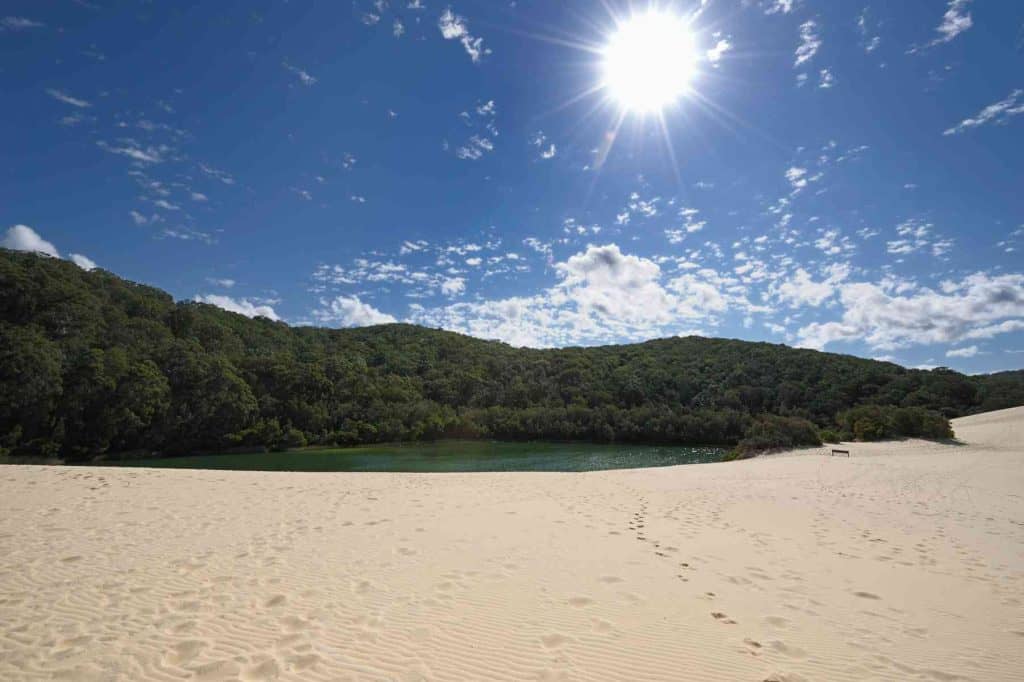
K’gari, the world’s largest sand island and a UNESCO World Heritage site, is full of contrasts, and spring is the perfect time to enjoy them all.
One moment you can be walking through lush rainforest growing straight out of sand, and the next you’re stretched out on a pristine beach with the Pacific rolling in beside you.
A swim at Lake McKenzie is a must. This perched freshwater lake, high in the dunes, is crystal-clear and filtered by pure silica sand.
The white sand feels soft underfoot, and the calm surface often mirrors the blue spring sky. On a warm afternoon, the cool water is a refreshing escape.
For longer adventures, spring’s mild conditions are ideal for the Great Walk or shorter hikes.
Wander the satinay forests around Central Station, climb to emerald-green Lake Wabby where a dune slowly encroaches, or stroll among the towering pines of Pile Valley.
Along 75 Mile Beach, the island’s sand highway, highlights include the rusting Maheno Shipwreck, the kid-friendly float at Eli Creek, and the colourful sand cliffs of The Pinnacles.
Early risers can also catch a spring sunrise from the beach – a magical way to start the day with only the sound of the waves and the vast shoreline to yourself.
Interested in a sailing adventure? The Fraser Island & Dolphin Sailing Adventure takes you across the Great Sandy Strait from Hervey Bay in search of dolphins, turtles and other marine life. You’ll enjoy a morning on the water with time for a swim at K’gari in the warmer months, boom-netting off the boat, and morning tea served on board. It’s a half-day trip, so you’ll still have the afternoon free for more exploring.
Wildlife Encounters

K’gari is alive with wildlife, and spring is one of the best times to see it.
Dingoes are often spotted trotting along the beach – they’re a symbol of the island, known for being the purest strain in Australia, so admire them from a safe distance.
Along the shoreline, migratory birds arrive for the season, with pied oyster catchers and terns busy feeding on the sandflats.
The waters around the island are just as rich in life.
Dugongs, dolphins, and turtles can often be seen, and a boat tour or kayak trip gives the best chance to spot them.
September and October also bring the tail-end of humpback whale season.
Many tours run from Hervey Bay, where mothers and calves rest in the calm bay before heading south, creating unforgettable close encounters.
On land, the rainforest boardwalk at Central Station offers the chance to see goannas basking and to hear yellow-tailed black cockatoos calling overhead.
And when night falls, spring skies are brilliantly clear, perfect for stargazing from a campsite, with only the ocean’s rhythm as background.
Practical Tips
Getting around K’gari is part of the adventure. As the world’s largest sand island, there are no paved roads – only sand tracks – so a 4WD is essential.
Access is by ferry from Hervey Bay or Rainbow Beach, and it’s best to book in advance, especially during the spring school holidays.
If you’d rather not tackle sand driving, guided 4WD bus tours cover the major sights without the stress.
Vehicle permits are required for Great Sandy National Park, and driving along the beach is safest at low tide.
There’s no separate entry fee, but permits for vehicles and camping are needed.
Spring is a popular time, though usually less crowded than summer, making it easier to find a campsite or accommodation.
Options range from beachside campgrounds and equipped sites like Eurong, Central Station, and Dundubara, to eco-lodges and resorts such as Kingfisher Bay on the western side or Eurong Beach Resort on the eastern shore.
Camping under the stars is especially rewarding in spring, with cool evenings perfect for a fire in designated areas.
Safety is essential on the island. Swimming in the ocean is unsafe due to rips and sharks, so stick to the freshwater lakes and creeks for a dip.
Insect repellent is handy for midges or mosquitoes, though they’re less of a nuisance in spring than in summer.
Stock up on supplies before boarding the ferry – small shops exist at Eurong and Happy Valley, but choices are limited.
3. Grampians National Park (Gariwerd), Victoria

Spring in the Grampians brings mild weather, flowing waterfalls, and trails lined with orchids, wattles, and colourful wildflowers.
The sandstone ranges offer sweeping views from lookouts like Boroka and Reeds, while kangaroos and emus are often seen around Halls Gap.
The park is also rich in culture, featuring ancient Aboriginal rock art sites that connect the landscape to thousands of years of history.
With its mix of hikes, wildlife, and heritage, the Grampians shine as a rewarding spring escape.
Why Spring?
Victoria’s Grampians (Gariwerd) feel magical in spring as the rugged mountains transform into a wildflower wonderland.
From August to November, hundreds of species bloom, earning the region its nickname of “Victoria’s Garden”.
Golden wattles, orchids, grevilleas, and colourful heaths cover the hillsides and valleys, turning even a simple roadside stop into a burst of colour.
The weather is perfect for hiking, with mild days warm enough for a t-shirt but without the extremes of summer or winter.
Wildlife is more active too.
Kangaroos graze near Halls Gap in the mornings and evenings, emus often wander with chicks in tow, and the forests echo with the calls of kookaburras, cockatoos, and bright parrots.
Spring also brings fewer visitors than the busy summer months, making it easier to find a quiet trail or book a campsite.
Scenic Hikes and Waterfalls
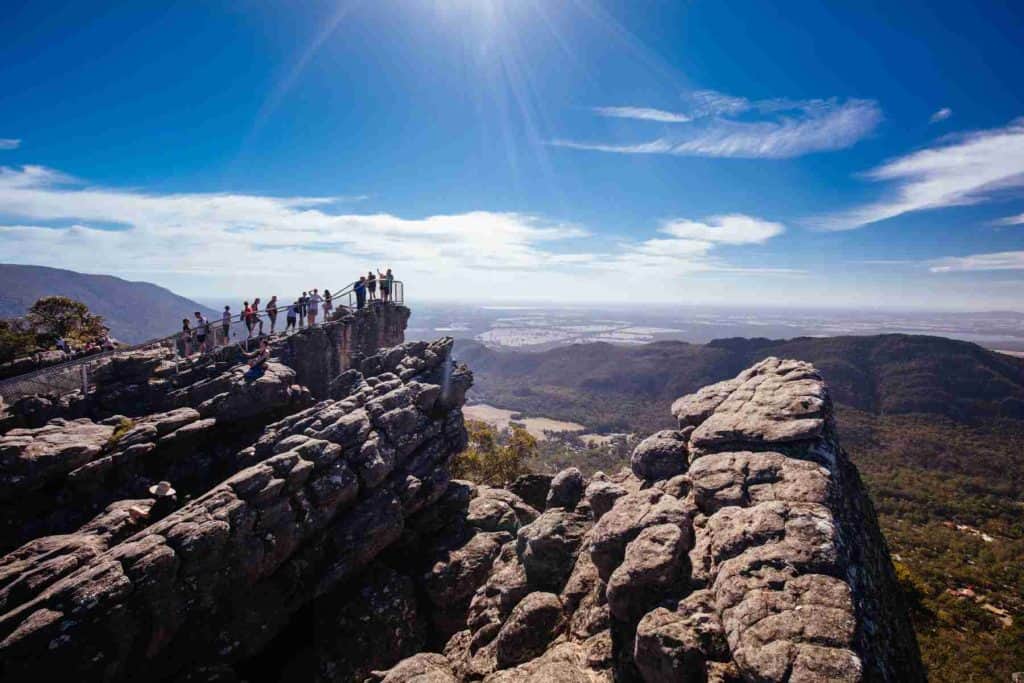
The Grampians are known for their dramatic lookouts, and spring is the perfect time to enjoy them.
Trails are comfortable in the mild weather and lined with wildflowers that add colour to every step.
The Pinnacle Walk from Halls Gap is a must, winding through rock formations like the Grand Canyon and Silent Street before reaching a cliff-edge lookout.
From The Pinnacle, the views stretch across Halls Gap and Lake Bellfield, with the valleys below glowing green and dotted with spring blooms.
Another favourite is the Balconies, also called the Jaws of Death. It’s a stroll through stringybark forest to two rock ledges that jut out like open jaws, a view that turns magical at sunset when the ranges glow blue and gold.
For those chasing a bigger challenge, the hike up Mt William – the highest peak in the park – rewards with 360° views that on a clear spring day seem to stretch forever.
Waterfalls are at their best in spring thanks to winter rains.
MacKenzie Falls is the star, tumbling powerfully into the gorge. The steep staircase down to the base is worth it for the thunder and spray of the falls, but there’s also an easier viewing platform at the top.
Silverband Falls, which often dries up in summer, reappears in spring, while Beehive Falls flows into a fern-fringed pool, with the walk there made even more stunning by wildflowers along the track.
Want to escape Melbourne for the day? The Grampians National Park with MacKenzie Falls and Kangaroos tour takes you into rugged mountain ranges and flower-filled valleys. You’ll hike to Boroka Lookout for sweeping views, walk out to the dramatic Balconies, and visit the stunning MacKenzie Falls. Along the way, enjoy time in Halls Gap and watch kangaroos in their natural habitat. With a small-group setting, it’s a relaxed and personal way to discover one of Victoria’s most beautiful regions.
Wildlife and Family Fun

The Grampians feel like a living open-range zoo, with wildlife everywhere you look.
Around Halls Gap, kangaroos graze freely on the grassy valley floor, often right outside campsites and cabins at dawn and dusk.
Emus also wander the plains, sometimes strolling past picnics without a care.
In spring, reptiles like shingleback lizards appear on warm rocks, and while snakes can be spotted, they’ll keep their distance if you stick to the tracks.
For families, the park is one big natural playground.
The Venus Baths loop from Halls Gap is a short, easy walk to smooth rock pools where kids can cool their feet.
The Brambuk Cultural Centre offers interactive displays about Jardwadjali and Djab Wurrung culture, with a cafe for a break.
Children also love scrambling on the boulders around the Wonderland area – always with care near cliffs – and the Elephant’s Hide is another fun spot for climbing.
Just outside the park, Halls Gap Zoo adds an extra experience, from hand-feeding kangaroos to seeing giraffes up close.
Even a simple drive at dawn or dusk can feel like a safari, with kangaroos bounding across the road and the chance of spotting an echidna waddling through the bush.
Spring makes these encounters even more frequent, so keeping a camera handy is a must.
Practical Tips
Entry to the Grampians is free, which is always a bonus.
The park sits about three hours west of Melbourne, with Halls Gap as the main base for exploring.
This small village has everything from caravan parks and campgrounds to motels, cottages, and B&Bs.
Spring is a popular time, especially during school holidays and wildflower season, so booking ahead for weekends is wise.
Camping is a great way to soak up the park – Halls Gap Lakeside is famous for kangaroo visitors, while Borough Huts near Lake Bellfield offer a quieter bush setting.
Many Parks Victoria campgrounds require bookings online.
A car is essential to get around, with sealed roads leading to most major sights like MacKenzie Falls, Boroka, and Reeds Lookouts.
Roads to places like the Balconies and Mt William are narrower but also sealed.
Spring weather is usually dry, though the odd shower can make roads slick, so take care and always watch for wildlife on the roadside.
Most trailheads are well-marked, and a park map from the Halls Gap Visitor Centre makes planning easy.
Accessibility is good at several lookouts, with Boroka a standout – just a short, flat walk from the car to a panoramic view.
Halls Gap itself has playgrounds, a supermarket, and cheeky cockatoos that often perch on balconies.
Fuel is limited and pricier in town, so top up before you arrive.
As for packing, layers are key – spring days can swing from warm afternoons to chilly evenings. That’s also perfect campfire weather, and many campgrounds allow fires in designated pits.
Few things beat roasting marshmallows under clear Grampians skies after a day of hiking among wildflowers and watching kangaroos graze nearby.
4. Uluru-Kata Tjuta National Park, Northern Territory

Spring is ideal for visiting Uluru-Kata Tjuta, with warm days, cool nights, and bursts of desert wildflowers brightening the red landscape.
Sunrises and sunsets paint Uluru in shifting colours, while mild temperatures make the base walk and the Valley of the Winds at Kata Tjuta more enjoyable.
The park is also a place of deep cultural significance. Ranger-guided walks and the Cultural Centre share Anangu stories and traditions, adding meaning to every view.
With manageable weather and powerful landscapes, spring offers the most rewarding way to experience Australia’s heart.
Why Spring?
There’s never a bad time to visit the heart of Australia, but spring feels just right at Uluru-Kata Tjuta.
From September to November, days sit in the mid-20s to low 30s °C, with cool nights that make exploring far more comfortable than the searing heat of summer.
It’s the season for walking the base of Uluru or tackling the Valley of the Winds at Kata Tjuta without the sun beating down too harshly.
Spring also brings a quieter feel, with fewer crowds than the busy winter months.
Sunrise platforms and sunset lookouts feel less packed, giving space to take in the colours as Uluru shifts from orange to crimson under the changing light.
If winter rains have fallen, wildflowers bloom across the desert – purple parakeelya, yellow sedges, even the striking red of Sturt’s desert pea – softening the rugged outback.
Even in dry years, spring light works its own magic. Sunrises and sunsets glow with a rich intensity, and nights are perfect for stargazing under crisp, clear skies.
Iconic Sights and Cultural Experiences
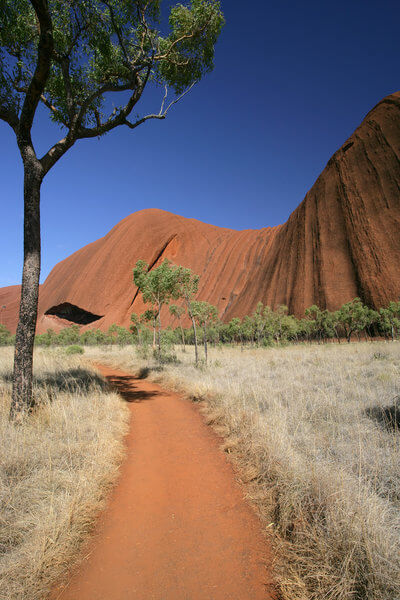
Uluru-Kata Tjuta National Park is home to two icons – Uluru and Kata Tjuta – and spring is the perfect season to experience both.
Start pre-dawn at a sunrise viewing area like Talinguru Nyakunytjaku. With a hot drink in hand, watch as Uluru glows red, then orange, while the desert birds call in the new day.
Spring mornings are mild, making it the best time for the 10.6 km Base Walk around Uluru. The trail is flat and easy, taking 3–4 hours if you do the whole loop.
Along the way, you’ll pass rock art sites, waterholes, and places tied to Anangu creation stories such as Mala and Kuniya Piti.
Free ranger-led walks add depth to the experience, sharing stories that bring the landscape to life.
The cultural connection here is profound, and in spring, you may even see seasonal bush foods and flowering shrubs used in traditional medicine.
Kata Tjuta, 40 km from Uluru, is equally rewarding.
The Valley of the Winds hike is the standout – a 7 km loop weaving between the ochre domes, with lookouts like Karu and Karingana offering sweeping views over the outback.
In spring, the track is cooler, wildflowers often line the trail, and after a wet winter, you may even spot frogs in rock pools.
For something gentler, Walpa Gorge is a one-hour return walk through a breezy canyon shaded by tall gum trees.
During the heat of the day, the Cultural Centre is the place to pause. Displays and galleries share Anangu culture and Dreamtime stories, and you can purchase authentic Indigenous art that supports the local community.
In the late afternoon, head to the sunset viewing area – Uluru’s shifting colours at dusk are unforgettable.
Please wait a little after the sun dips, as the rock often glows its deepest red in the post-sunset light.
Finish your spring day with the desert night sky. Stargazing here is breathtaking, with the Milky Way arching brightly across the horizon.
From your campsite or lodge, you’ll see thousands of stars, or you can join a tour or visit the Field of Light art installation, where 50,000 solar-powered bulbs mimic the stars in an enchanting desert display.
Short on time but don’t want to miss the magic of the Red Centre? The Uluru Sunrise and Kata Tjuta Half Day Trip lets you watch the sun rise over Uluru from the Talinguru Nyakunytjaku viewing platform, a truly unforgettable sight. You’ll also walk through the red desert of Walpa Gorge and stand beneath the mighty domes of Kata Tjuta. With hotel pickup, drop-off and a guided experience included, it’s the perfect way to see these sacred landmarks in just a few hours.
Wildlife and Nature

Uluru’s desert setting might look harsh at first glance, but in spring it feels alive with movement and colour.
Cooler days bring more wildlife out into the open.
Perentie lizards, Australia’s largest, can sometimes be seen sunning on rocks before slipping away.
Thorny devils also appear in spring as they breed, slowly trudging across the sand in search of ants.
Around campgrounds, dingoes are common visitors – secure your food and enjoy their howls echoing at night.
Birdlife thrives in the season.
Zebra finches flit through the bushes, wedge-tailed eagles circle high above the plains, and flashes of colour from crimson chats or budgerigars brighten the desert if seed is plentiful.
At dawn and dusk, kangaroos or even feral camels may appear near the roads, so drive carefully.
Spring can also turn the desert into a canvas of wildflowers. Pink mulla mulla, yellow daisies, and the striking red Sturt’s desert pea contrast vividly against the red earth.
Even in dry years, acacias bloom with creamy pompoms, and honey grevilleas add a sweet scent to the breeze.
Desert oaks sway softly with their feathery needles, creating a soundtrack for quiet walks.
In spring, Uluru is far from barren – it’s a living desert, rich with life for those who take the time to slow down and look closely.
Practical Tips
Uluru-Kata Tjuta National Park charges an entry fee of approximately $38 per adult for a 3-day pass, with children under 18 admitted free of charge.
It’s worth every cent, as the money supports park management and the Anangu community.
The park is remote – about 450 km from Alice Springs – but access is easier than it sounds.
You can fly directly into Ayers Rock Airport (Yulara) from major cities or road-trip via the Stuart and Lasseter Highways.
Spring is popular, though not as busy as winter, so book early.
Yulara, the resort town just outside the park, has options for all budgets – from the Ayers Rock Campground with BBQs and a pool to lodges like Outback Pioneer or hotels such as Desert Gardens.
Waking up to Uluru on the horizon from your tent or campervan is unforgettable.
Guided experiences are plentiful too: sunrise camel rides to the dunes, sunset motorcycle tours, and Anangu-led cultural tours with bush tucker tastings or dot painting workshops are especially enjoyable in the mild afternoons.
Packing smart makes all the difference.
The desert sun is intense, so bring a hat, sunscreen, and at least 1–2 litres of water per person for walks.
Nights and mornings can be cold, so layer with a light jacket.
Good walking shoes are essential, and a fly-net hat becomes handy later in spring.
Respect for country is vital – Uluru is a sacred site, so climbing is permanently closed and certain areas are signposted as no-photography zones.
Stick to the trails, move slowly, and take the time to feel the presence of this place.
5. Karijini National Park, Western Australia
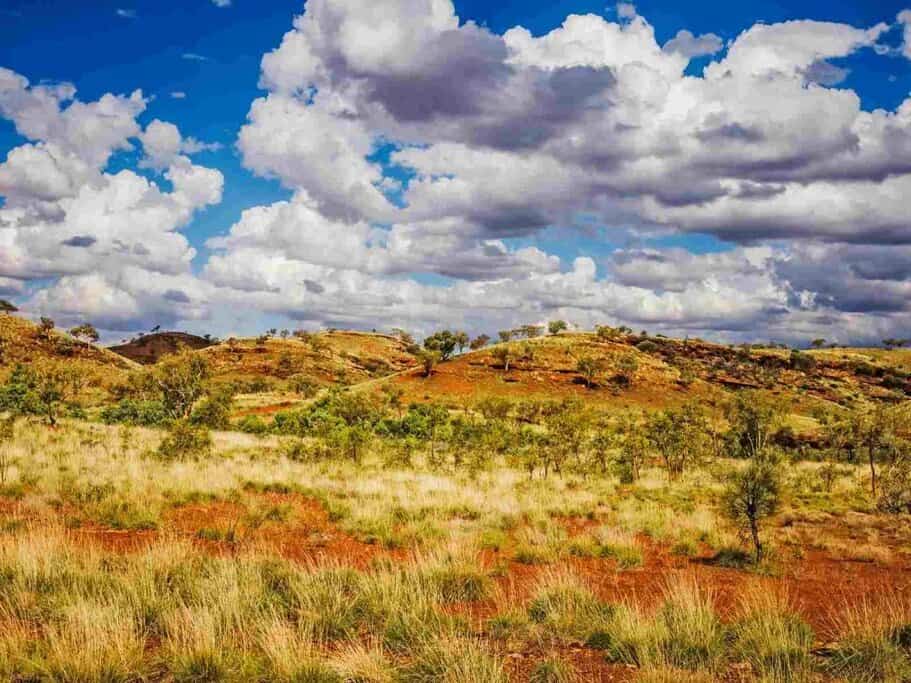
Spring is the perfect time to explore Karijini’s dramatic gorges and hidden pools.
Mild weather makes the hikes down into places like Fern Pool, Fortescue Falls, and Circular Pool comfortable, with shaded waterholes offering the ideal cool-down.
Above the gorges, the Pilbara plains burst with wildflowers – purple mulla mulla, yellow blooms, and spinifex glowing against the red cliffs.
With clear skies by day and brilliant stars at night, spring delivers Karijini at its most rewarding, whether you’re camping under the outback sky or staying at the Eco Retreat.
Why Spring?
In the remote Pilbara, Karijini is an outback oasis of deep gorges and emerald pools, and spring is the best season to explore it.
From September to early October, daytime highs sit in the mid-20s to low 30s °C – warm but not the extreme 40+ °C that summer brings.
Nights are cool enough for comfortable sleep, so hiking and camping are far more enjoyable.
Spring also falls at the end of the dry season, which means clear skies and little chance of rain.
It’s perfect for long days on the trails and stargazing nights at camp.
This is when wildflowers brighten the rugged red earth, with yellow cassias, purple mulla mullas, white flannel bush, and even pink desert roses adding colour to the spinifex plains and gorge rims.
Wildlife is more visible, too. Kangaroos, rock wallabies, goannas, and birdlife thrive year-round, but in spring they’re easier to spot at dawn and dusk in the milder conditions.
Gorge Adventures and Waterfalls
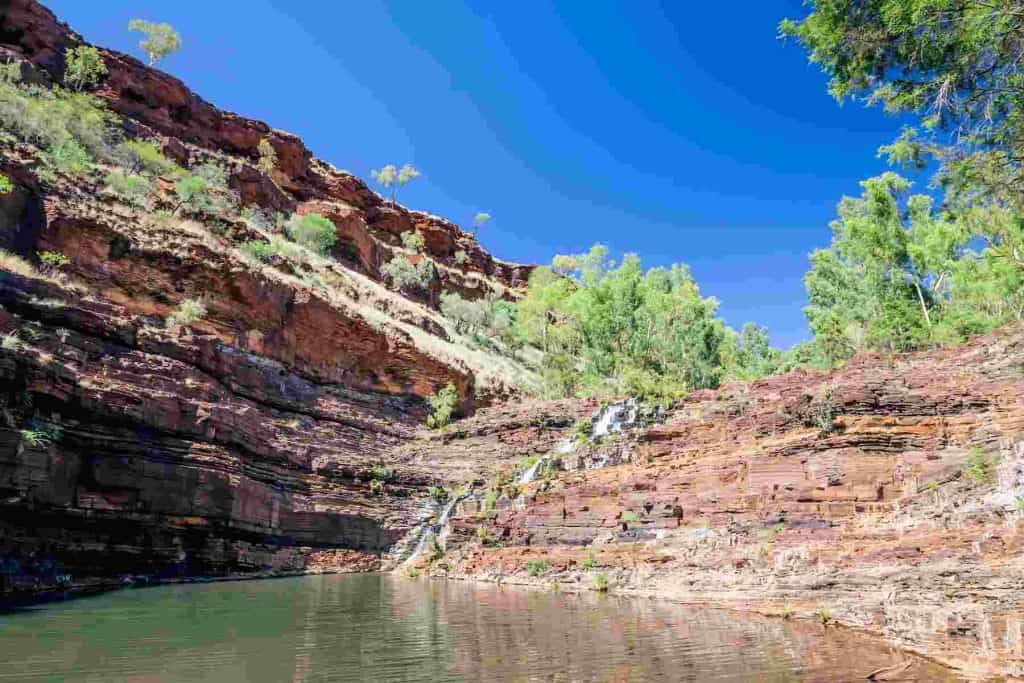
Karijini is defined by its gorges – deep chasms hidden in the Pilbara’s red earth, each with its own character.
Spring is the perfect time to explore them, with swimming holes warmed by the end of winter and minimal risk of flash floods.
Dales Gorge is a great starting point—a trail winds beneath tree ferns and gums to Fortescue Falls, the park’s only permanent waterfall.
In spring, it flows steadily, tumbling into a clear pool where you can cool off or sit on the sunlit rock steps nearby.
Just upstream, Fern Pool feels like an oasis, shaded by ferns and gum trees.
Sacred to local Aboriginal people, it’s a peaceful spot to swim, often with dragonflies hovering over the jade-green water.
Circular Pool, at the opposite end of the gorge, sometimes trickles in spring if the trail is open – a tucked-away gem worth checking.
For more adventure, head west to Weano and Hancock Gorges.
These require scrambling and wading, but spring’s mild temperatures and low water levels make them inviting.
The descent into Handrail Pool, where you grip a rail to lower yourself into a turquoise pool ringed by sheer walls, is unforgettable.
Hancock Gorge features the playful “spider walk” through a narrow passage, leading to Kermit’s Pool – a serene green waterhole tucked between cliffs.
These gorges feel like hidden worlds, with cool streams, smooth rock walls, and soft spring light perfect for photography.
If you’d rather stay dry, lookouts are just as dramatic.
Oxer Lookout gives a safe bird’s-eye view into the junction of four gorges – a sheer, jaw-dropping panorama.
Joffre Falls Lookout reveals a massive amphitheatre-shaped gorge, with water sometimes flowing lightly in spring.
Kalimina Gorge, with its layered banded iron formations and a small waterfall at one end, offers a quieter loop hike.
Nature and Wildlife
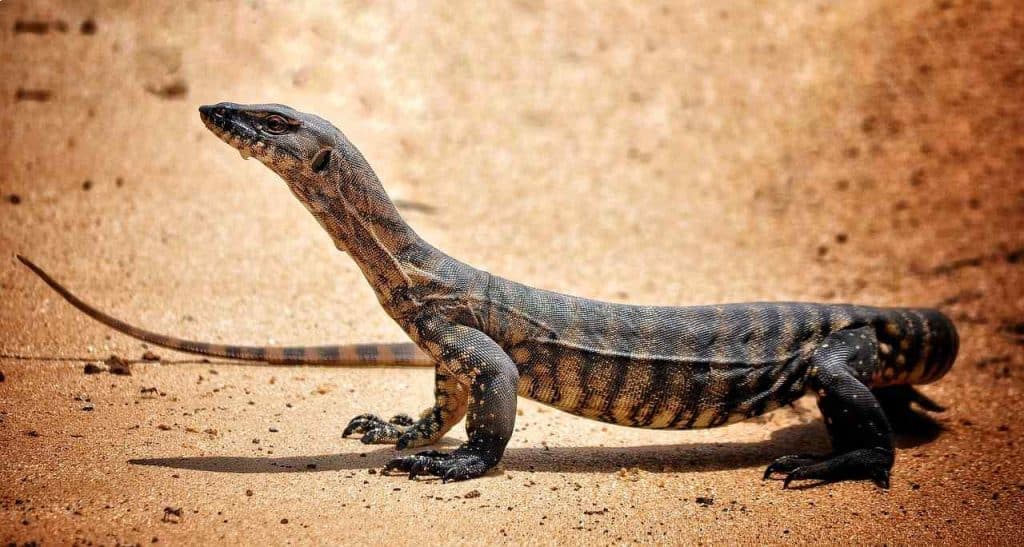
Karijini may not be about big game, but it’s teeming with life if you know where to look – and spring is one of the best times to notice it.
Around campgrounds at dusk, red kangaroos and wallaroos graze in the open.
In the gorges, black-flanked rock-wallabies can sometimes be seen at dawn, bounding across cliff ledges or quietly drinking at Fern Pool or Circular Pool.
Birdlife here is spectacular. Spinifex pigeons scuttle near waterholes, their little crests bobbing as they move.
Australian ringneck parrots flash green and yellow among the trees, while rufous whistlers fill the air with song.
Overhead, brown falcons and wedge-tailed eagles soar on thermals above the escarpments.
Spring is also when smaller wonders appear. Thorny devils, those tiny spiky lizards perfectly camouflaged against the red earth, are more active during their breeding season.
Goannas – from giant perentie to smaller sand monitors – often cross tracks or bask in the sun.
Wildflowers aren’t the only blooms in spring. Butterflies gather in clouds around pools, dragonflies skim the surface of creeks, and sometimes desert mushrooms even sprout after rare rain.
Early mornings and evenings are the best times for spotting wildlife, when the heat eases and the Pilbara’s living desert reveals itself in full.
Practical Tips
Karijini is remote – around 1,400 km north of Perth – but it’s worth the journey.
The easiest access is to fly into Paraburdoo or Newman, then drive. Accommodation is simple: either camp or glamp.
The Karijini Eco Retreat near Joffre Gorge offers safari tents, cabins, and a campground, with the bonus of a bush restaurant and bar for that well-earned drink under the stars.
On the east side, Dales Gorge campground has unpowered sites (bring your own water).
In spring, rangers often run evening talks here, a great way to learn more about the park. Spring is the peak season, so book the Eco Retreat well ahead if you want a tent or cabin.
Entry is $15 per vehicle per day (or grab a WA holiday pass). Please keep your receipt, as it covers multiple entries on the same day. Roads are a mix of sealed and unsealed.
The drive to Dales Gorge is sealed, while the western gorges like Weano and Hancock involve gravel. In spring’s dry conditions, most 2WDs can manage if you take it slow and watch for sharp rocks.
Bring plenty of water, a wide-brimmed hat, and sturdy closed-toe shoes – the gorge trails are rocky and sometimes slippery.
A fly net is handy by late spring when bush flies appear.
Nights in September can dip to around 10 °C, so pack a warm sleeping bag, while by November the heat builds, so start hikes early.
Swimming in the gorge pools is a highlight, though the water is always cool. A quick-dry towel and reef shoes help with slippery rocks.
Safety is key here. There’s almost no phone reception, so let someone know your plans, stick to marked tracks, and carry a basic first aid kit.
Class 4 and 5 trails are rugged, so know your limits. That said, thousands of visitors safely explore Karijini every year, especially in spring’s mild conditions.
